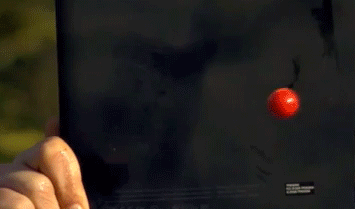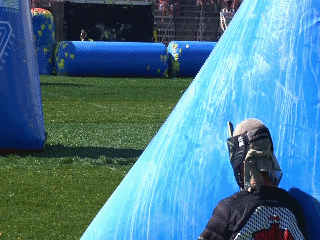Impact for Distance
This page shows how distance affects the impact force and
impulse of a paintball hitting a target. The animation below
(left) shows how brittle paintballs are and how explosive they
are when fired at a solid object. However with the right
equipment, such as padding or baggy cloths, the change in
velocity can occur over a longer period of time, making the
paintball less likely to break on impact. This same concept
explains why paintballs bounce off of inflatable bunkers so
easily, shown by the animation below (right).


In order to determine the impact force (impulse) of the
paintball hiting it's target, the following equations must be
used.
Where
v
is equal to v because the collision is considered to be
inelastic so the paintball comes to complete stop. Also,
t
is equal to the time of transit of the paintball's diameter.
Therefore
d
is the diameter of the paintball. The impact force can be
decreased by increasing the period of time the paintball is
decelerating. This can be accomplished by increasing
d
by wearing padding/baggy clothes or by being fat.
This should help:
| Distance
(m) |
Force
(N) |
Impulse
(Ns) |
| 0 | 1549.59 |
0.2927 |
| 10 |
1506.23 |
0.2886 |
| 20 |
1464.67 |
0.2846 |
| 30 |
1424.81 |
0.2807 |
| 40 |
1383.26 |
0.2765 |
| 50 |
1343.44 |
0.2725 |
| 60 |
1308.50 |
0.2690 |
| 70 |
1269.07 |
0.2649 |
| 80 |
1234.19 |
0.2612 |
| 90 |
1203.61 |
0.2580 |
| 100 |
1166.41 |
0.2539 |
Notation:
:
the terminal velocity of the projectile
: the
mass of the projectile
: the
gravitational acceleration on the projectile
: the
density of the fluid through which the object is moving
: the
projected area of the object
:
the drag coefficient of the projectile
:
the projectile acceleration in the x direction
:
the projectile acceleration in the y direction
: the
time difference from when the projectile is launched
:
the projectile velocity in the x direction
:
the projectile velocity in the y direction
:
the initial velocity at which the projectile is launched
:
the angle at which the projectile is launched
: the
magnitude of the sum of the x and y velocity vectors
: the
distance from the origin in the x direction
: the
distance from the origin in the y direction
:
the average force on the projectile
:
the change in velocity of the projectile
:
the difference in time
the
difference in position of the projectile
:
the change in momentum of the projectile
Contsants:
(average mass of a paintball)
(gravity on earth)
(air density at 1 atm and 30 degrees celcius)
(cross sectional area of a paintball)
(drag coefficient for a smooth sphere)
(diameter of a paintball)